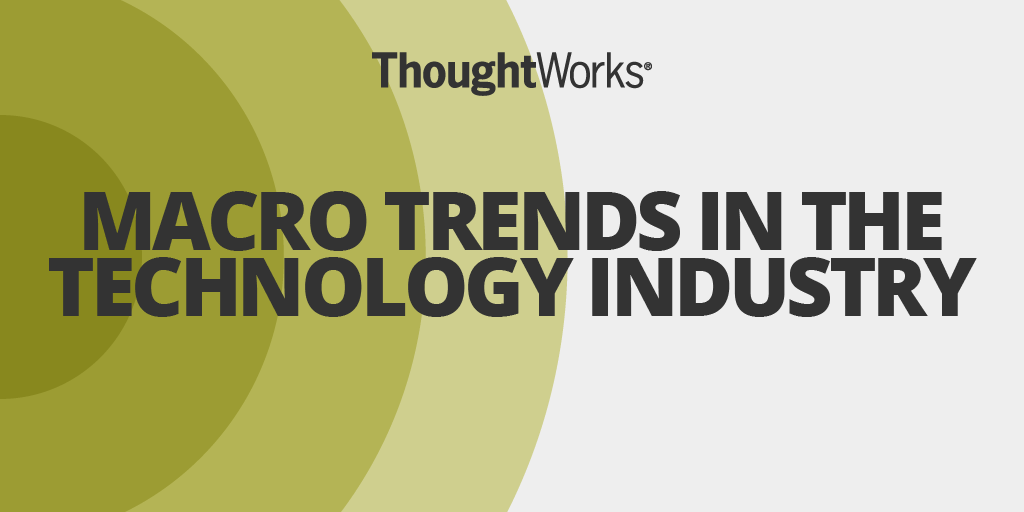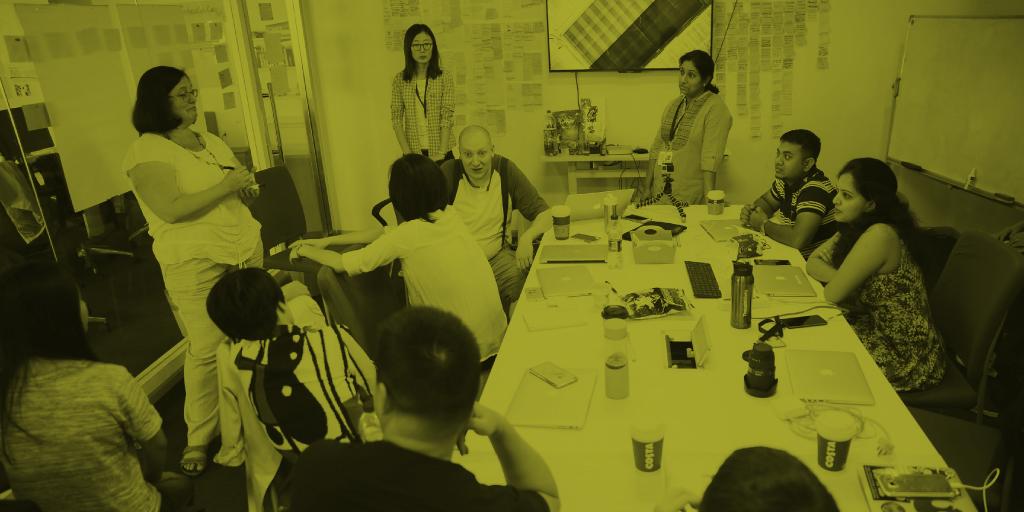
Macro Trends in the Tech Industry
We publish our Technology Radar twice a year: it’s a snapshot of current and future technologies that we think are important and relevant across the industry. In this piece, we highlight some of the macro trends that can’t be covered directly in the Radar.

Systems are getting more intelligent and interactive
Whilst we are usually cautious about peak-hype-cycle technology—3D printing, QR codes and gamification have had significant hype in the past—there is currently an explosion of interest in machine learning, artificial intelligence, and related tech such as autonomous vehicles. The technologies underlying intelligent systems are sound, proven to work, and are fed by the massive data troves organizations have built up over the last few years. All of the large industry players—IBM, Google, Amazon and others—have announced significant investments, creating an “AI war chest” of cash to spend, similar to previous spending on cloud tech. Samsung’s recent acquisition of Viv, the next-generation digital assistant designed to best Apple’s Siri, proves that this stuff is important for more than just the internet software giants. We agree, and are optimistic that machine intelligence will usher in a new era of business capabilities, evolving from workflow-centric to decision-centric applications. Businesses will use machine intelligence insights to deliver more engaging experiences to customers and provide better service as well as better business decision making. We need to be careful, however—these learning systems base their insight upon historical “training” data, so rather than being an a priori improvement, many will simply perpetuate existing decision making bias, whether we understand that bias or not.
Augmented and virtual reality are heading towards the mainstream, with business interest in VR beyond gaming and in novel applications of AR to improve productivity and to enable new kinds of working, such as remote expert systems. The technology is still developing and requires specific skills such as 3D modeling, but we believe organizations should be preparing today for this new wave of interaction. Soon, VR and AR will be mainstream capabilities that organizations must build, buy or rent. You should ask yourself “what kind of experiences will we build?” VR and AR allow natural interactions between humans and the digital world. When someone puts on a VR headset for the first time their natural instinct is to reach out to objects in the digital world around them, and with advanced controllers and even hand-finger tracking, this kind of interaction will be possible.

Social design is as important as technical design
Developers have long known that the social aspects of software creation are more critical than the actual technology in use, and today we are seeing a wider appreciation for the holistic effect of team structure. Structuring an organization into small teams who have clearly defined “customers”—whether external or internal—and a clear set of success criteria empowers those teams to deliver wildly better results. This kind of structure has been enabled by technologies such as self-service cloud, PaaS, microservice architecture and by the DevOps cultural movement. “Two pizza” teams that build and run software and are accountable to drive a business metric are rapidly being adopted by mainstream enterprise. We wholeheartedly endorse this trend.
Diversity continues to be a challenge for the tech industry, despite studies showing that diverse teams perform better. The giants of Silicon Valley are putting significant effort into diversifying their largely white, male workforces, but unfortunately, as with this Facebook example, hiring women or people of color into the tech community is difficult. There are some bright points, however. The Anita Borg Institute, a nonprofit focused on the advancement of women in computing, named Thoughtworks as the winner of their 2016 Top Companies award. Whilst it’s great to be able to write about this with Thoughtworks having won first place, dozens of companies submitted their data and are making great strides in improving diversity in their workplaces.
Platforms underpin tech advances
The word “platform” is increasingly overloaded—and important—in the tech industry today. Current use of the word platform may mean a traditional heavyweight system such as SAP or Oracle, modern cloud infrastructure such as a Platform-as-a-Service, or even ambitious strategies such as “business-as-platform.” As an example of overloading of the word ‘platform’, consider the multiple meanings within an organization wanting to pursue machine learning and AI. To take advantage of machine intelligence, today’s enterprise needs a data strategy to nurture and grow their data assets. That data strategy will include a choice of data platform, running on an underlying infrastructure platform such as Cloud Foundry or OpenShift. The data strategy itself may be seen as an enabler for a machine intelligence “decision support platform” for the business. Although the term is overloaded and somewhat confusing, “platform thinking” is an important part of the tech industry today.
Since the last Radar, we see a range of new testing strategies or ‘things’ to test. Good testing practices are key to implementing techniques such as Continuous Delivery for rapid “concept to cash” cycles as well as for delivering high quality, reliable software. Flexible visual testing tools such as FBsnapshottestcase and Galen indicate an increase in automated UI testing, particularly for complex or responsive UIs. Security test tools gain more emphasis as our industry continues to grapple with security breaches, with items on this radar including container scanning, the OWASP dependency checker tool and Talisman. Whilst these tools tend to employ deterministic scanning, on the horizon we see a range of AI-powered security tools that can automatically learn what is ‘normal’ and respond to conditions that deviate from those norms.
While rumors we’ll all be replaced by robots in the next six months are overstated, the pace of technology change and adoption continues to increase.
An enterprise with their finger on the pulse will be well placed to leverage these technology trends to their advantage. The most successful new products and services will combine advances in user interaction, autonomous product teams, and business decisions made through “intelligent empowerment”—systems that use machine intelligence paired with human intuition and flexibility to deliver outcomes vastly better than machine or human alone.
Disclaimer: The statements and opinions expressed in this article are those of the author(s) and do not necessarily reflect the positions of Thoughtworks.

















